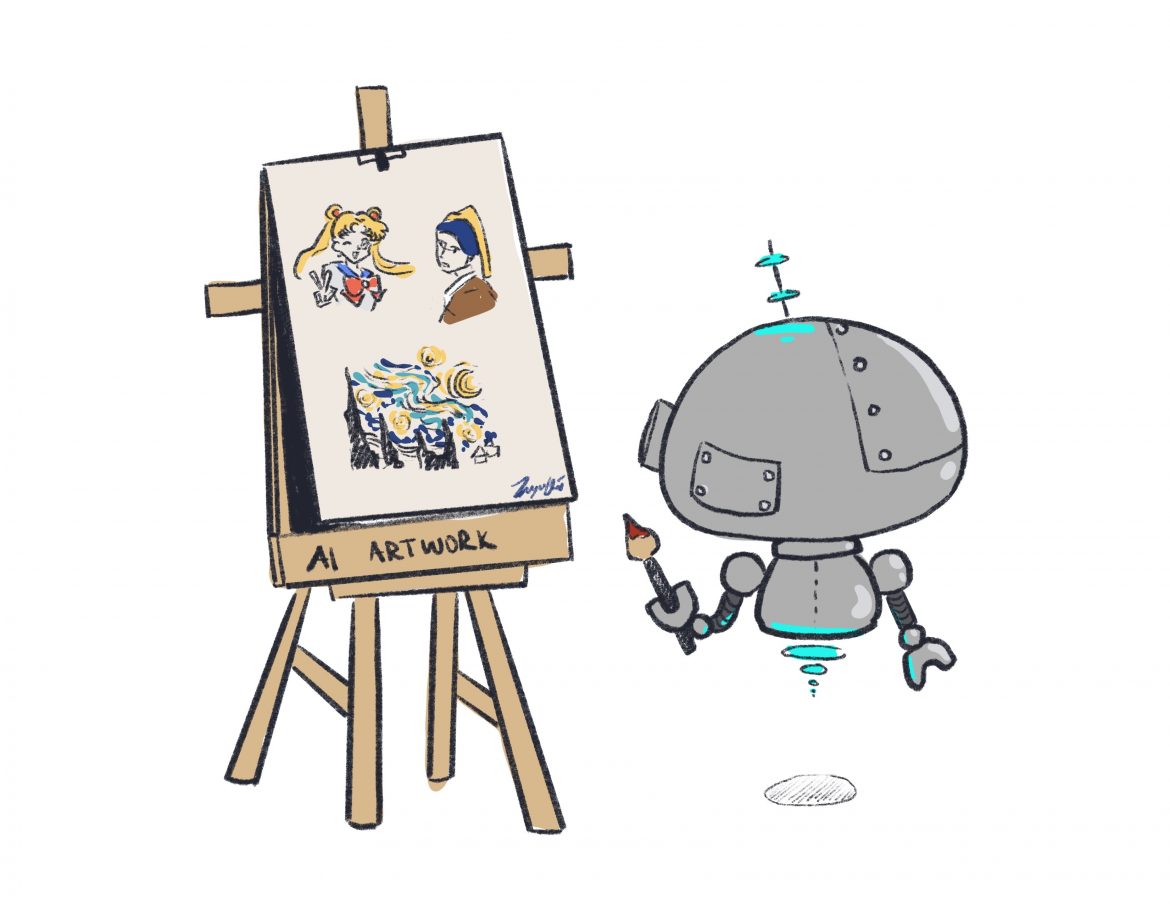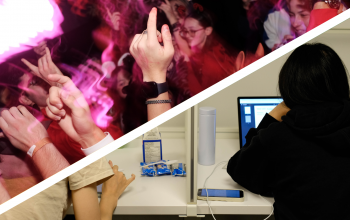Illustration credit: Joyce Qiu, Illustration Editor
AI has nothing on artists… but it has a lot that belongs to them
Claudia Doyle, Arts Editor
In the last year, artificial intelligence has taken the art world by storm. As a digital artist who posts art on social media, I have seen firsthand how independent creators are becoming more vulnerable to the ruthless challenges of using the internet to promote their work. Examining the ethical and legal repercussions of the latest trends in AI art provides an opportunity to explore some of these challenges, and to appreciate the resilience of artists as they adapt to new changes in the art market.
The Tech-Savvy Artist
As technology advances, more and more artists are turning to digital art. Digital art is easy to upload to different websites, is accessible to prospective buyers, and is very much in demand. Even traditional artists must frequently scan their work for clients, portfolios, or promotional purposes. Posting my own art on Instagram seemed like a no-brainer; all my favourites, who are well-established digital artists, have had a lot of success on the platform, garnering followers that became customers. I was interested in building my brand in a similar way. Instagram offered me a place to share my work, get feedback, and become inspired by other artists. And in my first year on the app, I had a great time learning helpful tips and tricks about digital art, a medium that is tricky to use but very rewarding once you get the hang of it.
As a full-time student, I post art at my own pace to improve my art and business skills as I complete my university degree. But a lot of artists that I follow rely on social media to make a living. They use social media to find work through commissions, selling prints, and promoting the work they are doing for other companies (as these are usually contracted projects, after which they will have to find new work). Some artists link their social media profiles to their Patreon, where they share video tutorials and bonus content with their monthly subscribers to make additional income. Working in a commercial setting with little creative freedom can lead to burnout and artist block, which is why independent artistry has emerged as its own profession. These independent artists make their own rules, deciding what they will charge, what projects they will accept, and what they want their brands to look like. However, with this flexibility comes undeniable precarity, especially as social media becomes increasingly fast-paced.
In recent years, artists have been disappointed by Instagram’s ever-changing algorithm. Many have seen a stark drop in engagement, as their posts reach fewer followers than they previously did. Currently, the algorithm favours accounts that post frequently and that prioritize the Reels feature. This means that artists have to jump through many hoops to get engagement. Not only do they constantly need to be creating art to post, but also do they have to act as their own publicists by putting together Reels and remaining active on the app. Despite all this effort, posts are often hit or miss, and if the algorithm doesn’t put the artist’s work on the Explore page (you can see where your post gets engagement in the professional dashboard section), the post is usually a miss. The artist is left feeling discouraged because they spent so much time on a piece that didn’t get the appreciation it deserved.
While independent artists rely on social media platforms, the internet is relentless in providing them with obstacles. Instagram should value and prioritize the artists that saturate the app with beautiful posts, and who risk having their art stolen in doing so. I first learned about the ethical issues created by artificial intelligence art through a few heated posts by some of the larger independent artists that I follow. Most of them admitted that they had initially been intrigued by AI, only to be later disappointed when they learned how it operates and affects artists who post content on the internet. I can’t help but view AI as yet another obstacle artists will need to jump over to find work. In other words, AI is only going to exacerbate the precarity that comes at the price of an artist’s independence on the internet.
Artists versus Artificial Intelligence
Artificial intelligence art is generated by a machine learning process. The machine learns through various techniques and creates new images for its users. One of the most popular AI art generators is DALLE, which describes itself as a “system that can create realistic images and art from a description in natural language.” In other words, all the user needs to do is give the system a text prompt, and artificial intelligence will come up with a response to the prompt in the form of an image. Another popular example is the app Lensa, which includes an AI filter that allows users to render their selfies in different art styles. It is not difficult to see the appeal of these easy-to-use applications. People who simply want to have some fun with imaging software can use them to bring their ideas to life, but this has traditionally been the job of real-life artists.
Independent artists largely rely on commissions, where individual customers or companies will request that an artist create something specific for them. Digital artists who find work on social media experience various issues when working on commission. Anyone can ask for one, and it can be difficult to discern who is making a serious request if the request comes from a random Instagram account. Moreover, artists must be wary of customers who will fail to pay for the art they have asked for. The introduction of AI into the art market is not helping this issue. Some users on Instagram will even try to sell AI art and pass it off as work done by themselves, which can harm the credibility of real digital artists and affect their ability to find work.
AI systems like DALLE present a sterilized, impersonal version of a commission. The user can only use a few words to explain what they want, and the result may not be to their liking. Real commissions for artists include a wide array of jobs: company logos, children’s book illustrations or personal cards, to name a few. The customer builds a relationship with the artist to ensure that they get exactly what they want. Ultimately, you get what you pay and wait for. The quality of an AI-generated image is questionable at best, and customer satisfaction is certainly not guaranteed. Unfortunately, this can be of little consolation to real artists whose main concern is how AI art generators are creating new images.
AI art generators use a process in which a machine draws from a large library of millions of scraped images. Using this data, the artificial intelligence can learn certain image styles without exactly copying the images that it has seen. Crucially, this model requires the use of other artists’ work to be able to create its own, and this is where copyright law begins to get blurry. There is always a risk that the machine will create an image that is too close to an original scraped image. Even more concerning is how the machine finds these images. It appears that any art posted to the internet is at risk of being fed to AI, and the artists get no say in the matter. For artists on social media, this phenomenon is especially worrying because they need to post artwork on the internet to find jobs and make connections, but in doing so they are putting their art at risk of being used without their consent. And as artificial intelligence in the art world is a new phenomenon, there are no legal precedents to determine how to proceed with the copyright issues that are arising.
However, there are some lawsuits that are currently trying to establish new boundaries. One example is a lawsuit filed by Getty Images against Stability AI, the company behind the Stable Diffusion software that uses scraped images. Getty Images is alleging copyright infringement, claiming that Stability AI has stolen images from them. Of course, Getty Images is a large company that has the means to fight a big court battle. Independent artists don’t always have the time or resources to do this, although there is another promising lawsuit that has been filed by individual artists seeking damages from companies like Stability AI. These artists are also accusing AI generators of stealing billions of copyrighted images. They are seeking compensation and hope to stop this theft from continuing. To prove their allegations, they will have to demonstrate that AI companies profit off copyrighted images. These lawsuits are certainly a fascinating start, but they are only scratching the surface of how AI can affect artists.
AI Has Nothing on Artists
What is really at stake here is artistic integrity. Independent artists will often speak of their own distinct “style,” referring to their unique way of rendering features according to what looks visually appealing to them. When I first started digital art, I watched a lot of YouTube videos that offered tips on how I could develop my own personal art style. The most common piece of advice from other artists was to pick and choose aspects of other people’s styles to get started. This may not seem very different from the AI technique of using other people’s work to come up with a new image, and interestingly, this process actually mirrors artistic education in a way because artists learn by copying other artists. The difference is that AI art involves stealing art and passing it off as something original. Meanwhile, artists use their own creativity to find what kind of style works for them. And, if they must copy directly to learn, they are honest about their sources and give credit to the original artists.
I have also come across the argument that AI can help artists in some ways. For example, if an artist is looking for inspiration, could they not just type a prompt into DALLE and use the generated image as a reference for their own creation? Personally, I have a hard time believing an artist would need a tool like that, as they should have the creative capacity to sketch or Photoshop a reference for themselves. And what about people who simply don’t have this creative capacity? Again, I don’t think anyone would have to turn to this kind of application. If you’re feeling the need to use artificial intelligence to make art, maybe it’s a sign that you have the motivation and desire to become an artist yourself! Any artist will tell you that art is a matter of practice, a skill that you can develop with enough time and drive.
AI has nothing on artists, but it has a lot of artists in its databases. If AI art becomes more advanced and continues to attract users to the level that it has this year (as it most likely will), more legal frameworks will need to be put into place to protect independent artists. I will end by shouting out fellow digital artists who post work on their social media accounts not to have it stolen by robots, but rather to share their work and gain support for it. Of all the AI art that is floating around on the internet right now, I have yet to find an image that perfectly replicates the unique artistic style of any artist that I follow on Instagram. This means that real artists offer unique skills that cannot be rendered obsolete by AI. Their creative style is their selling point, and I highly recommend following and supporting real artists on social media if you are looking for an artist to commission, or simply to inspire you.




